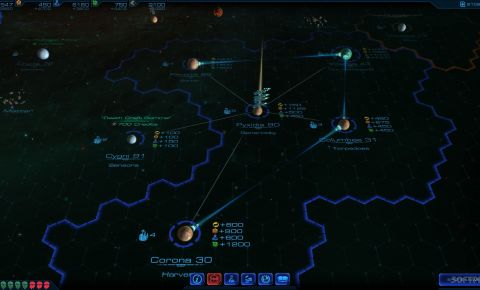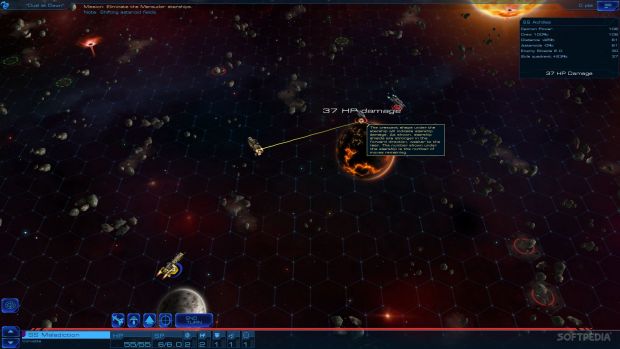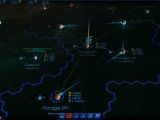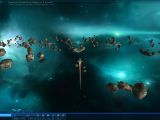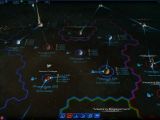Sid Meier's Starships made me hate torpedoes and cloaked ships during my first few campaigns because I was constantly getting missions in which my enemies managed to get close to my ships without being detected and I was taking higher than expected losses.
I decided to tweak my fleet setup in order to have good scanners and use torpedoes of my own and then the game seemed to promptly deliver missions in which fighters dominated the skies.
The missions in the new Firaxis title are randomized, of course, but it's a sign of the strength of the core mechanics that I was creating narratives around my victories and losses.
Sid Meier's Starships is not as complex as Civilization, but it offers a solid mix of strategy and tactics that focuses on the effects of player choices and on the development of unique strategies for a customizable fleet of ships.
Story
Playing Sid Meier's Starships sometimes feels like experiencing a very long and extra violent season of Star Trek, because both the names of some missions and the overall tone are close to the way the show portrayed a diverse galaxy where everyone had a problem, and it seems that there's only one force that can make everything right.
Gamers will be able to initially chose from eight potential rulers, each with their own starting advantage, and they can also focus on one of the Affinities that were initially introduced in Civilization: Beyond Earth.
This means that there are 24 potential starting combinations that change up the early game and there are interesting advantages for a variety of play styles.
Sid Meier's Starships allows gamers to create a narrative which focuses on how one federation can grow from one planet to the position of dominating the galaxy by doing favors, taking control of planets, gathering resources and making sure that they take out the competition.
Each campaign feels unique, although the missions tend to become familiar after a while, but the writing manages to be both science fiction-infused and a little ironic and will appeal to all those who spent their childhood watching Star Trek and have remained in love with the genre ever since.
Gameplay
Sid Meier's Starships starts off with a small fleet hovering in orbit over a planet that has been heavily developed by its civilization and challenges players to use classic turn-based mechanics in order to defeat their enemies, complete missions and earn the allegiance of other world to dominate the galaxy.
Players can travel to as many planets and execute as many missions as possible as long as their crew is not overcome with fatigue, which means that there's a lot of tactical flexibility when the player acts.
For each planet, gamers need to deal with a mission, which is extracted from a relatively large but not inexhaustible catalog, and it's important to take into account the power of the enemy and the potential rewards before committing the fleets to action.
Once the fleet is ready for action, the game moves to a hex grid and introduces planets and asteroids as obstacles, as players seek to take out enemy ships in straight battles or focus on movement and territory control in order to save civilians and protect other vessels.
A ship has a movement allocation for each turn and can fire its weapons once and their capabilities are supplemented by those of fast and fragile fighters and by the use of both stealth and enhanced detection.
Facing enemies and damage types are important in combat, and gamers will have to experiment a little in order to find the strategies that work for them, but the combat never feels very difficult when playing on Normal difficulty.
I ended up creating one very tough frontline ship which can draw fire and launch fighters while its companions stay further back and use torpedoes or lasers and speed to respond to threats.
“The AI powering the enemy fleets is capable most of the time, but it often exposes its ships a little too much when it seems to have numerical superiority.”
On the strategic map, it also works well to consolidate territory and to take planets away from the player when it's possible.
With the resources earned from missions and generated by friendly planets, gamers will need to upgrade their ships, aiming to create a balanced force, but they can also improve their own empire and research new strategies.
Sid Meier's Starships is initially about creating a power base by convincing unaligned planets to join a cause or another, but it then evolves towards standoffs between powerful empires, and diplomacy, although basic, becomes important.
Later on, the fleets increase in size and gain capabilities and the engagements between two opposing factions involve more firepower and careful use of terrain and special abilities, with the question of victory or defeat often resolved after tense turns where 20 or 30 HP make the difference.
The best thing about Sid Meier's Starships is that it is the kind of title where it's easy to abandon a campaign because of a mistake or a lost battle and start over, enjoying once again the sense of discovery of the first few turns and opening possibilities that the layout of the planets presents.
The biggest problem of the new Firaxis title is that the end game is not that interesting because engagements between big federations are not as exciting as the early rush to secure territory and develop it.
Graphics and audio
Sid Meier's Starships has a clean, informative and futuristic look which serves it well, but this is not a beautiful game in the strictest sense of the world.
Players will spend most of their time looking at a star system chart, which offers a lot of details about the planets that can be visited, the resources they can offer and the missions that can be executed.
Once gamers commit their ships to battle, a hex-based grid is used to show the space where the various forces will do battle and players will get a closer look at their vessels and the various planetoids and asteroids they can use to create and execute a strategy.
It's easy to explore the content in Sid Meier's Starships and to get all the info needed for long-term strategy, and the mission profiles associated with each planet have distinctive and often beautiful art associated with them.
Sid Meier's Starships also offers an adequate science fiction-themed soundtrack, but the combat and exploration sounds do not stand out in any way.
Multiplayer
Sid Meier's Starships does not feature a multiplayer mode and that is maybe the one design decision that's almost impossible to understand.
The structure of the game and the rhythm introduced by the Shore Leave indicate that it's very easy to imagine how two or more humans could play a game, with clear limits set for turn times and the option to replace those who take too long with AIs in the long term.
There are Leaderboards to compare performances, but it would be great to see this become a multiplayer experience via a post-launch patch and test my skills against other living players.
The Good
- Tactical combat mechanics
- Engaging player choices
- Array of leaders and Affinities
The Bad
- Repetitive missions
- Escort objectives
- No multiplayer
Conclusion
The game shows Sid Meier knows how to make games that, using a few basic concepts, offer ways to create unique stories to share with other players, while making sure that each move the gamers make will have a clear impact on the future of their federation and fleet.
The strategic layer of the game is its biggest accomplishment, with carefully interwoven concepts supporting the development of the faction, and its biggest problem in the long term is the relatively limited set of mission types available, which seems small even for the price of 14.99 dollars or Euro.
 14 DAY TRIAL //
14 DAY TRIAL // 